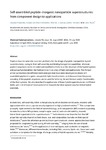Mostrar o rexistro simple do ítem
Self-Assembled Peptide–Inorganic Nanoparticle Superstructures: From Component Design to Applications
| dc.contributor.author | Pigliacelli, Claudia | |
| dc.contributor.author | Sánchez-Fernández, Rosalía | |
| dc.contributor.author | García, Marcos D. | |
| dc.contributor.author | Peinador, Carlos | |
| dc.contributor.author | Pazos, Elena | |
| dc.date.accessioned | 2022-09-21T08:41:26Z | |
| dc.date.available | 2022-09-21T08:41:26Z | |
| dc.date.issued | 2020-06-04 | |
| dc.identifier.citation | C. Pigliacelli, R. Sánchez-Fernández, M. D. García, C. Peinador and E. Pazos, Self-assembled peptide–inorganic nanoparticle superstructures: from component design to applications, Chem. Commun., 2020, 56, 8000–8014. https://doi.org/10.1039/D0CC02914A | es_ES |
| dc.identifier.issn | 1364-548X | |
| dc.identifier.uri | http://hdl.handle.net/2183/31672 | |
| dc.description.abstract | [Abstract] Peptides have become excellent platforms for the design of peptide–nanoparticle hybrid superstructures, owing to their self-assembly and binding/recognition capabilities. Morover, peptide sequences can be encoded and modified to finely tune the structure of the hybrid systems and pursue functionalities that hold promise in an array of high-end applications. This feature article summarizes the different methodologies that have been developed to obtain self-assembled peptide–inorganic nanoparticle hybrid architectures, and discusses how the proper encoding of the peptide sequences can be used for tailoring the architecture and/or functionality of the final systems. We also describe the applications of these hybrid superstructures in different fields, with a brief look at future possibilities towards the development of new functional hybrid materials. | es_ES |
| dc.description.sponsorship | We are thankful for the funding received from the European Research Council (ERC) under the European Union's Horizon 2020 research and innovation programme (grant agreement no. 851179), the Ministerio de Economía y Competitividad and Fondo Europeo de Desarrollo Regional (FEDER) (CTQ2016-75629-P), the Agencia Estatal de Investigación and FEDER (CTQ2017-89166-R) and the Consellería de Educación, Universidade e Formación Profesional, Xunta de Galicia (ED431C 2018/39). E. P. thanks the UDC-Inditex InTalent Programme for her research contract and funding and the Xunta de Galicia for the Oportunius Programme | es_ES |
| dc.description.sponsorship | Xunta de Galicia; ED431C 2018/39 | es_ES |
| dc.language.iso | eng | es_ES |
| dc.publisher | Royal Society of Chemistry | es_ES |
| dc.relation | info:eu-repo/grantAgreement/EC/H2020/851179 | es_ES |
| dc.relation | info:eu-repo/grantAgreement/AEI/Plan Estatal de Investigación Científica y Técnica y de Innovación 2013-2016/CTQ2016-75629-P/ES/NUEVOS SISTEMAS SUPRAMOLECULARES DINAMICOS. ESTABILIZACION SELECTIVA DE G-QUADRUPLEXES CON ESTRUCTURAS METALOCICLICAS/ | |
| dc.relation | info:eu-repo/grantAgreement/AEI/Plan Estatal de Investigación Científica y Técnica y de Innovación 2017-2020/CTQ2017-89166-R/ES/HERRAMIENTAS PEPTIDICAS PARA APLICACIONES BIOLOGICAS: SENSORES INTELIGENTES PARA ESTUDIAR NITRACION DE PROTEINAS Y NANOMATERIALES CON FUNCIONALIDADES MODULABLES/ | |
| dc.relation.uri | https://doi.org/10.1039/D0CC02914A | es_ES |
| dc.title | Self-Assembled Peptide–Inorganic Nanoparticle Superstructures: From Component Design to Applications | es_ES |
| dc.type | info:eu-repo/semantics/article | es_ES |
| dc.rights.access | info:eu-repo/semantics/openAccess | es_ES |
| UDC.journalTitle | Chemical Communications | es_ES |
| UDC.volume | 56 | es_ES |
| UDC.issue | 58 | es_ES |
| UDC.startPage | 8000 | es_ES |
| UDC.endPage | 8014 | es_ES |
| dc.identifier.doi | 10.1039/D0CC02914A |
Ficheiros no ítem
Este ítem aparece na(s) seguinte(s) colección(s)
-
GI- Quimolmat - Artigos [104]
-
OpenAIRE [332]






